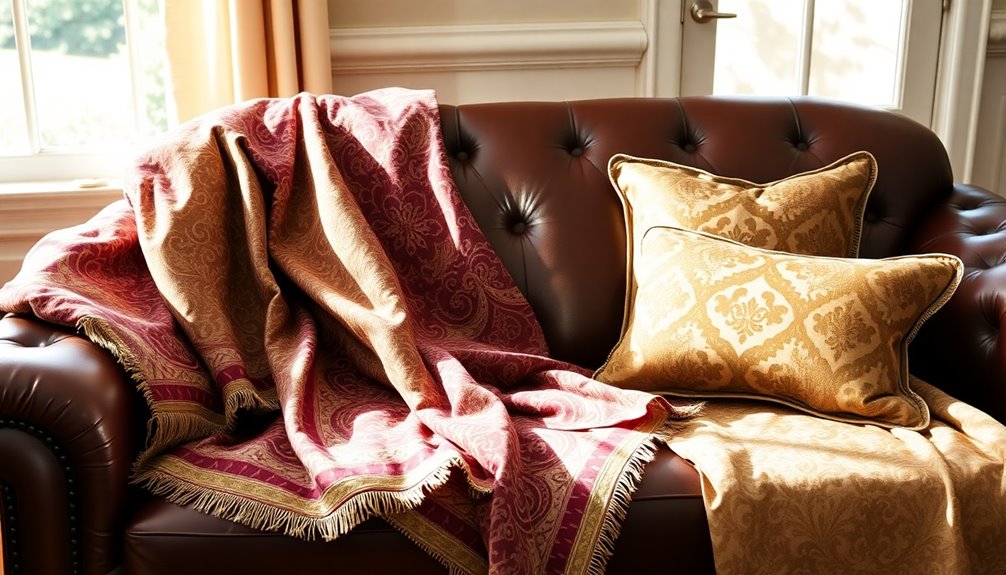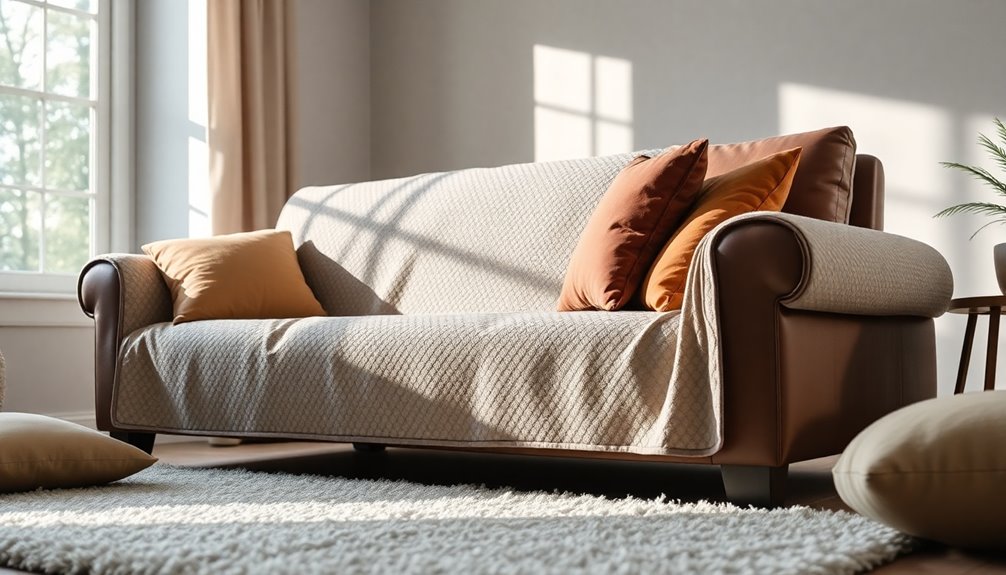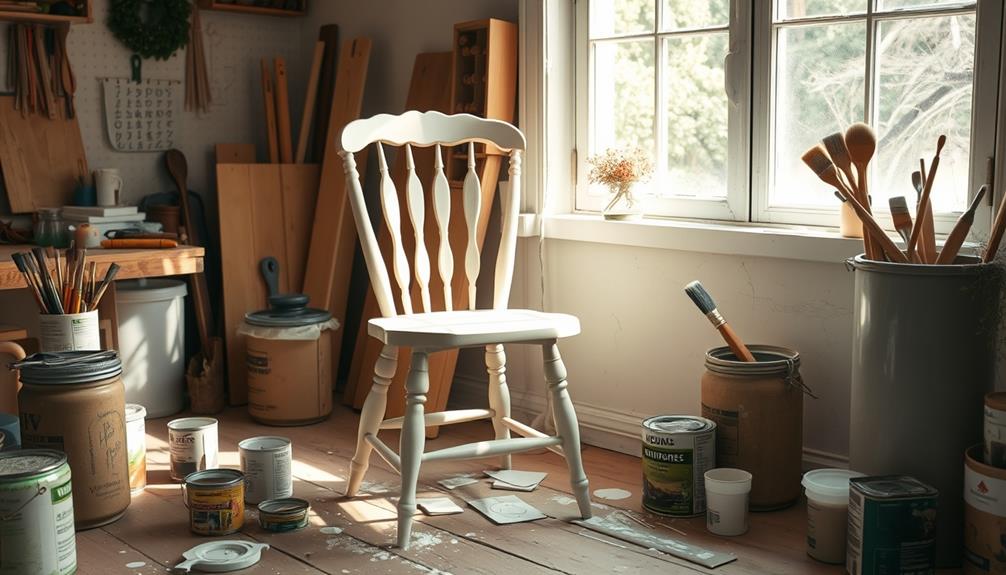To cover your leather sofa effectively, start by choosing a protective slipcover or fabric that suits your style. Look for stretchable materials that fit snugly and guard against spills and scratches. It’s essential to measure your sofa accurately for a custom fit. Consider layered options like decorative throws to enhance aesthetic appeal while offering extra protection from sun damage. Regular machine washing of covers will keep them fresh. Don’t forget maintenance—apply leather conditioner to prevent wear. If you’re curious about specific fabric choices and their benefits, you’ll find more useful tips ahead. Additionally, when deciding how to cover your sofa, think about the color palette of your room to ensure that the slipcover complements your existing decor. If you have pets, opt for fabrics that are easier to clean and highly durable to withstand daily wear and tear. With the right slipcover and proper care, you can successfully transform your leather sofa into a stylish, protected centerpiece in your living space.
Key Takeaways
- Use stretchable fabric slipcovers for a snug fit that protects against spills and scratches while enhancing the sofa's aesthetic appeal.
- Consider custom-fit covers designed for specific sofa models to ensure proper coverage and style.
- Regularly wash removable covers gently in the machine to maintain cleanliness and appearance.
- Choose protective coatings or water-resistant fabrics to simplify cleaning and prevent damage from spills.
- Measure your sofa accurately, including depth and height, before purchasing covers to ensure a proper fit.
Introduction

Keeping your leather sofa in top shape requires regular care and attention. You'll want to incorporate routine dusting and conditioning, along with vacuuming and using a leather cleaner to maintain its luster. And when accidents happen, treating wine spills immediately is key to preventing lasting damage.
Routine Dusting and Conditioning
To maintain the beauty and longevity of your leather sofa, regular dusting and conditioning are essential. Start by dusting your sofa with a soft, dry cloth to prevent dirt and debris from building up. Focus on seams and crevices where dust tends to accumulate, ensuring you cover every inch of your leather sofa cover. This simple routine helps keep your sofa looking pristine.
Next, conditioning is key. Every 6 to 12 months, apply a specialized leather conditioner to replenish moisture and prevent cracks. This keeps the leather supple and extends its lifespan. Make sure to choose products specifically formulated for leather care; harsh cleaners can damage the surface and affect its finish.
Additionally, consider the environment in which your leather sofa lives. Keeping it away from direct sunlight and heat sources will help prevent fading and drying out, which are detrimental to the leather's integrity. By regularly dusting and conditioning your leather sofa, you're not just preserving its appearance but also ensuring it remains a cherished piece of furniture for years to come.
Vacuuming and Leather Cleaner
Vacuuming your leather sofa is a crucial step in maintaining its pristine condition. Regular vacuuming helps remove dust and debris that can scratch the leather surface. Make sure to use a soft brush attachment, as this will prevent any damage while effectively lifting dirt.
Once you've vacuumed, it's time to clean your sofa with a leather cleaner specifically formulated for leather furniture. Avoid regular household cleaners, as they can strip away the natural oils essential for keeping your leather soft and supple. Apply the cleaner using a soft cloth, working in a circular motion to ensure even coverage and maintain the leather's natural sheen.
After cleaning, conditioning your leather with a leather balm or conditioner is vital. This restores moisture and helps extend the lifespan of your sofa. Remember, routine maintenance, including vacuuming and cleaning every few months, significantly enhances the appearance and durability of your leather sofa. If you're using sofa covers, make sure they're compatible with the cleaning products you choose, as this will help keep both the cover and your sofa in tip-top shape. Regular care makes all the difference! Additionally, maintaining the right indoor temperatures in your living space can further protect your leather furniture from environmental damage.
Treating Wine Spills Immediately
Accidentally spilling wine on your leather sofa can feel like a disaster, but acting quickly can prevent lasting damage. First, grab a clean, dry cloth and gently blot the area to absorb as much liquid as possible. Avoid rubbing, as this can push the stain deeper into the leather. Next, mix equal parts distilled water and white vinegar. Using a soft cloth, apply this solution to the stained area, dabbing rather than scrubbing.
After treating the spot, rinse the area with a damp cloth to remove any residue from the vinegar solution. Then, dry the area thoroughly with another clean cloth. To maintain your leather's integrity, apply a leather conditioner once it's dry. This step restores moisture and helps prevent cracking after cleaning.
For peace of mind, always test any cleaning solution on an inconspicuous spot of your sofa first to ensure it won't cause damage. If you frequently entertain guests, consider using couch covers to protect your leather sofa from spills and stains in the future. Taking these steps can keep your leather looking fabulous for years to come!
Shielding From Sun Damage

To protect your leather sofa from sun damage, consider using scratch-resistant furniture fabrics that can withstand wear and tear. Fabric drapes can also enhance protection while adding an aesthetic touch to your room. By layering durable fabric, you create a barrier that helps maintain your sofa's beauty and longevity.
Scratch-Resistant Furniture Fabrics
When it comes to protecting your leather sofa, scratch-resistant furniture fabrics offer a smart solution against both wear and sun damage. These fabrics are engineered to withstand daily wear and tear, making them perfect for homes with pets and children. By layering your sofa with sofa slipcovers made from scratch-resistant materials, you can significantly prolong the life of your leather furniture.
A key benefit of these fabrics is their protective coating, which guards against harmful UV rays and prevents sun damage and fading. This is crucial for maintaining the rich appearance of your leather sofa over time. Additionally, many scratch-resistant options are also water-resistant or possess stain-repelling properties, making them easier to clean and maintain.
Investing in these durable materials not only enhances your sofa's longevity but can also save you money in the long run by reducing the need for frequent replacements or repairs. When selecting scratch-resistant fabrics, be sure to check for high-performance ratings and warranties that guarantee their effectiveness against damage and fading. This way, you're ensuring your leather sofa remains a beautiful centerpiece in your home for years to come. Furthermore, using these protective fabrics can also contribute to enhanced hygiene by minimizing the accumulation of dust and allergens on your sofa's surface.
Fabric Drapes for Added Protection
Adding fabric drapes to your living space is an effective way to shield your leather sofa from harmful sun damage. Prolonged exposure to UV rays can lead to fading and deterioration, but with the right drapes, you can protect your investment. Choose light-colored drapes to reflect sunlight, reducing heat buildup and preserving the leather's integrity.
When selecting fabric for your drapes, opt for UV-resistant materials. These fabrics not only block harmful rays but also add an extra layer of protection against sun damage. Regularly closing or adjusting your drapes during peak sunlight hours can significantly extend the lifespan of your leather furniture by minimizing direct exposure.
Incorporating drapes into your decor doesn't just serve a functional purpose; it enhances your room's overall aesthetic. Well-chosen drapes can complement your existing design while providing a stylish shield. So, take the time to select the right fabric and color for your drapes, and you'll create a cozy space that keeps your leather sofa looking pristine for years to come.
Using Durable Fabric Layers
Using durable fabric layers is a smart way to protect your leather sofa from sun damage while enhancing your home's style. High-performance perennial fabric serves as an excellent couch cover, effectively shielding your sofa from harmful UV rays. This not only preserves the leather's color and texture but also allows you to refresh your living space with seasonal updates without the hassle of reupholstering.
Consider mixing materials like breathable cotton or linen with sturdy upholstery fabric to create an additional barrier against fading and wear caused by sunlight. Layering these fabrics not only looks great but also adds a practical element to your decor.
To keep your leather in top shape, regularly apply leather balm; this helps maintain its suppleness and prevents drying out from sun exposure. Plus, ensuring that your layered fabric is machine washable makes maintenance a breeze, allowing you to keep your couch cover clean and effective in providing protection. By implementing these durable fabric layers, you'll give your leather sofa the care it needs while elevating the aesthetic of your home.
Reinforcing Couch Frame Stability

To keep your leather sofa sturdy, you'll want to address any frame joint weaknesses. Using techniques like corner brackets or adding plywood can significantly enhance stability. Plus, don't forget to regularly check those bolts and screws to maintain a solid foundation.
Frame Joint Weaknesses
Frame joint weaknesses can seriously compromise the stability and comfort of your leather sofa. If you want to cover a leather couch effectively, you'll need to ensure the frame is sturdy. Weak joints can lead to instability, making it uncomfortable to sit on. It's essential to assess the type of wood in your sofa's frame. Softwoods like pine may need extra support compared to more durable hardwoods like oak or maple.
Regularly inspect your frame joints for signs of wear or loosening. Catching these issues early can prevent larger problems down the line. If you notice a loose joint, applying wood glue can offer a quick fix. For more extensive issues, you might need to disassemble the frame and add reinforcements such as brackets, dowels, or corner blocks to enhance durability.
Once you've addressed the weaknesses, using a staple gun to secure the upholstery around the reinforced joints helps maintain the frame's integrity while giving your couch a polished look. By taking these steps, you ensure your leather sofa remains comfortable and stable, ready for years of use.
Couch Frame Reinforcement Techniques
Reinforcing your couch's stability is essential for a comfortable and long-lasting piece of furniture. To start, consider adding corner braces to the joints of your sofa. This simple adjustment can significantly reduce wobbling and enhance the overall structural integrity. If you notice any loose joints, utilize wooden dowels or metal brackets to secure them, preventing further damage and improving durability.
For sofas that sag, adding plywood panels underneath the cushions provides extra support and helps distribute weight evenly across the frame. Regularly inspect and tighten all screws and bolts to ensure the frame remains stable and free from movement over time. This proactive maintenance can extend the life of your sofa.
Additionally, think about incorporating a solid base or extra support legs. This will help distribute weight more evenly, especially for heavily used or larger sofas. By implementing these couch frame reinforcement techniques, you'll create a sturdy foundation that enhances both comfort and durability, ensuring your investment lasts for years to come. Don't overlook these necessary steps; they'll make a noticeable difference in your sofa's performance.
Cozy Fabric Layering Technique
Layering soft fabric over your leather sofa not only boosts comfort but also helps support the couch frame's stability. By adding layers of cozy fabric, you evenly distribute weight across the surface, reducing stress on the leather and reinforcing the overall integrity of your couch. This technique is especially useful for maintaining the longevity of both the leather and the fabric.
When selecting your fabric, opt for durable and breathable materials like cotton or polyester blends. These will provide warmth and comfort while protecting the leather beneath. Ensure the fabric fits snugly to avoid slipping; using non-slip backing or tucking the fabric tightly can help achieve this.
Don't forget about your couch covers! They can enhance the cozy feel while offering additional protection. Regular maintenance is key, so be sure to vacuum the layered fabric and occasionally clean the leather underneath. This approach not only preserves the aesthetic charm of your leather sofa but also ensures it remains sturdy and stable for years to come. Embrace the cozy fabric layering technique, and enjoy the added comfort and durability it brings to your living space!
Personalized Fabric Design Choices

Personalized fabric design choices can truly transform your leather sofa, allowing you to showcase your unique style while seamlessly blending with your existing decor. You can choose from a range of options, from classic and modern looks to playful patterns like Maze and Leaf. Selecting swatches that complement your interior design style is crucial for achieving a cohesive appearance.
High-performance perennial fabrics provide a budget-friendly solution, ensuring your couch makeover is both aesthetically pleasing and durable. Custom slipcovers tailored to your sofa's dimensions ensure a snug fit, enhancing the overall look of your furniture.
When it comes to fabric types, consider cotton blends or synthetic options based on your household's needs. If you have pets or children, durability and maintenance requirements become essential factors in your decision-making process.
You might also explore DIY upholstery projects, which offer a creative outlet while being cost-effective. The popularity of TikTok transformations shows that you can easily personalize your leather sofa and make it uniquely yours. With the right fabric choices, your leather sofa can become a reflection of your personal style and a cherished part of your home.
Maintenance for High-Traffic Areas

To keep your leather sofa looking great in high-traffic areas, regular maintenance is essential. Start by applying leather balm regularly to maintain suppleness and protect against wear. This is especially important where friction occurs most often. Consider investing in couch covers or protective throws designed for high-traffic areas. These can shield your leather from scratches and spills, giving you peace of mind.
Always keep a microfiber cloth handy to address spills immediately. Wiping up moisture quickly prevents it from seeping into the leather, which can lead to staining and deterioration. Additionally, rotate your cushions periodically to ensure even usage and minimize wear on any single part of the couch.
Don't forget to use furniture protectors like felt pads under items placed on the sofa. They can significantly reduce scratches and damage caused by the shifting of objects. By incorporating these simple practices, you'll not only prolong the life of your leather sofa but also keep it looking fabulous, even in spaces that see a lot of action. With a little effort, your sofa will remain a stylish and durable centerpiece in your home.
Moreover, regular maintenance practices can help you save on unexpected repair costs, similar to how preventive maintenance for appliances can extend their lifespan.
Conclusion

In summary, covering your leather sofa is a smart investment that not only enhances its appearance but also provides essential protection against everyday wear and tear. By using covers, you can safeguard your sofa from spills, scratches, and the inevitable wear that comes with daily use. This proactive approach significantly extends its lifespan and maintains its aesthetic appeal.
There are various types of covers to choose from, such as slipcovers, fitted covers, and stretch covers, each made from materials ranging from genuine leather to budget-friendly faux leather. When selecting a cover, it's crucial to ensure it matches your sofa's specific style and dimensions. Proper installation involves tucking extra fabric into crevices for a snug fit, ensuring the cover stays in place.
Regular maintenance of your covers, including gentle machine washing and spot cleaning, will help preserve both their appearance and functionality. While many users appreciate the ease of installation and the transformation covers bring, be aware of potential sizing issues or slipping. Accurate measurements before purchase can help you avoid these problems. Overall, investing in quality covers is a smart choice for protecting your leather sofa. Additionally, ensuring that you regularly trim your cat's nails can prevent damage to your sofa and keep it looking its best.
Frequently Asked Questions
Can You Put a Cover Over a Leather Couch?
Yes, you can definitely put a cover over a leather couch! It'll protect your furniture from spills, scratches, and everyday wear, helping to extend its lifespan. Look for leather-specific covers that fit securely and maintain the couch's aesthetic. Many options are machine washable, making cleaning a breeze, especially if you've got pets or kids. Just make sure to choose the right size and type for a snug fit that won't slip.
Is It Worth It to Reupholster a Leather Sofa?
If you're considering reupholstering your leather sofa, think about its sentimental value and condition first. It can be worth the investment, especially since a professionally done job can extend its life by 10 to 15 years. Weigh the costs against purchasing new furniture. If you love your sofa and want to personalize it, reupholstering can give it a fresh look that matches your decor while preserving its original charm.
Can You Cover a Leather Sofa in Fabric?
Yes, you can definitely cover a leather sofa in fabric! By using slipcovers or tailored fabric, you can enhance your sofa's look while protecting it from wear and tear. Just make sure to choose a durable, stretchable fabric that fits snugly. Accurate measurements are vital to avoid any bunching. Many fabric covers are machine washable, so maintenance's a breeze. This simple step can also help extend your sofa's lifespan and save on reupholstering costs.
Can a Leather Sofa Be Changed to Fabric?
Yes, you can change a leather sofa to fabric! It involves reupholstering, where you remove the leather and replace it with a new fabric. First, measure your sofa accurately to select the right amount of material. Look for durable, budget-friendly fabrics for a lasting makeover. If you're feeling adventurous, you could even tackle the project yourself, saving on labor costs. Just make sure to communicate with suppliers about your fabric choices!









